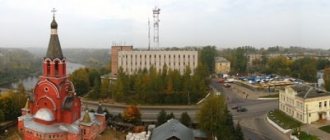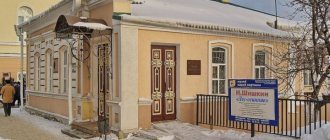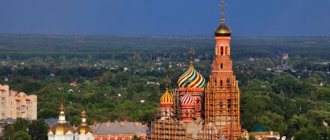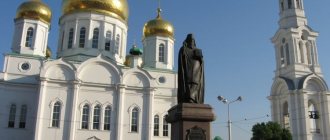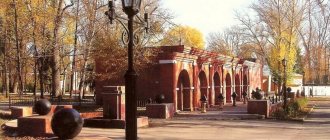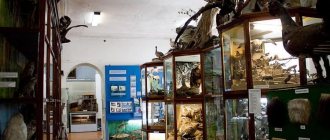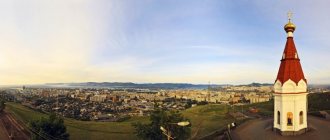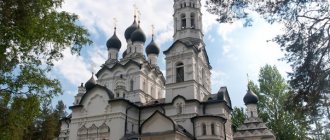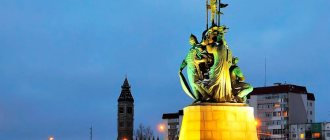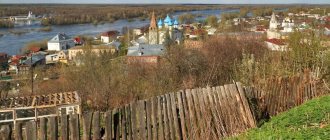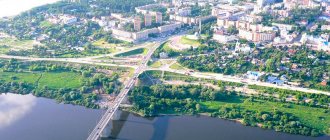Sights of Udmurtia
Udmurtia today. The Udmurt Republic is one of the constituent entities of the Russian Federation and is territorially part of the Volga Federal District.
It occupies an area of 42,100 sq/km and has a population of 1,528 thousand people. It borders with the Kirov region, Perm region, Tatarstan and Bashkortostan. The capital of the republic is the city of Izhevsk.
On the territory of the Republic there are such minerals as peat, coal and oil. The main waterways are the large rivers - Kama and Vyatka.
Sanatoriums of Udmurtia
Sanatorium "Uva"
Sanatorium "Uva"
The uniqueness of the health resort is that in the early 70s of the 20th century, two medicinal mineral springs with different compositions were discovered in this place - chloride-sodium-iodine-bromine-containing and sulfate-sodium. Such mineral waters are excellent for the treatment of heart and vascular diseases, diseases of the gastrointestinal tract and nervous system. Construction of the sanatorium, which began in 1974, took as long as 14 years due to the difficult terrain and swampy soil. But the result exceeded all expectations. Sanatorium buildings have grown up in the pine forest, in the center of which there is a beautiful pond, and a clean forest river flows nearby. The first vouchers were distributed among agricultural workers who came here from all over the Union. The collapse of the USSR did not have a negative impact on the sanatorium. Quite the contrary: the Ukrainians gained greater independence in their work and began to actively introduce new methods of treatment and therapy, such as apitherapy (treatment with bee venom), hirudotherapy (treatment with leeches), ozone therapy, as well as manual and reflexology. In recent years, areas such as therapeutic walking and horse riding have been actively developing. Also available to patients are hydromassage and mud baths, a gym and a gym. At the moment, the Uva sanatorium has 39 licenses in various medical fields, including gynecology, urology, treatment of eye and pulmonary diseases. They also successfully provide follow-up treatment for diabetes mellitus and restore the functions of internal organs after other serious illnesses. Reacting to the growing popularity of family vacations, the management of the sanatorium has created comfortable conditions for families with children.
Sanatorium “Varzi-Yatchi”
Sanatorium “Varzi-Yatchi”
This resort has longer traditions. The mud and mineral waters of the Yelabuga Zemstvo Council began to be used for medicinal purposes in the 40s of the 19th century. However, at that time there were no equipped places for this. Those who wanted to be cured came here with their own baths and heated the mud on earthen stoves. It was only in 1889 that the Alexander Mud Hospital was opened on these lands. With the founding of the Izhevsk Medical Institute in 1932, a new stage in the development of the resort began, which included research into the medicinal properties of mud and mineral waters, the development of new methods and practices for the treatment and prevention of various diseases. The Great Patriotic War prevented the large-scale development of the resort, and this work was resumed only in the 70s, when construction of new facilities began on the territory of Varzi-Yatchi. The main healing resource of the sanatorium is low-mineralized, low-sulfide, high-ash peat mud, which is mined here. Thanks to “gray mud”, the center’s specialists successfully treat diseases of the nervous system, musculoskeletal system, urinary tract, digestive system, circulatory system, as well as andrological, gynecological, skin and other diseases. Of all the Udmurt sanatoriums, the following can also be distinguished:
- sanatorium "Ural Dawns";
- sanatorium "Svyazist";
- sanatorium "Energetik";
- sanatorium "Builder";
- sanatorium "Izhneftemash"
Museum in Bachkeyevo. Point of the Siberian Highway stage.
The museum building was built back in 1837 in the Igrinsky district of Udmurtia. The building was designated for overnight accommodation and recreation of prisoners and convicts who were sentenced to hard labor and exiled to Siberia. The shackles and hard bunks in which prisoners were shackled have been preserved here. You can taste porridge cooked over a fire, of course, not the same as what was fed to the prisoners; it used to be made from oats, but now it is cooked from millet. Museum workers will show you a well that has been preserved from those times and a forge where blacksmiths forged shackles. The museum hosts excursions, exhibitions and themed games with outfits in the style of two centuries ago. The museum building could not be restored; there was no need for it; it was perfectly .
Old and abandoned villages of Udmurtia
Abandoned villages of Udmurtia
Every year the number of uninhabited villages and settlements in Russia increases. It is difficult to say what is the root cause: urbanization, which lures young people to cities, as a result of which agriculture declines, or do young people go to the city, not seeing prospects for a prosperous life in depressed villages? Looking at the amount of untouched land available for farming, villages could thrive with the right approach. It is all the more sad to see abandoned houses in villages where life was once in full swing. It is quite difficult for an ordinary person to count the number of empty villages in Udmurtia. Only government agencies own this data. But finding an abandoned village in Udmurtia is definitely not a problem. Just ask one of the residents of residential villages where the nearest abandoned village is located.
Savapi village
One of the most typical examples of an Udmurt ghost village is Savapi, located 5 kilometers from the village of Oktyabrsky, Glazovsky district.
Savapi village
The name translates as “son of Savva,” after the founder of the village. It is known that before the revolution the Markov families lived here. Then several more families moved here, eventually forming 9 households. The settlement was surrounded by a fence, and the gates were closed at night. The inhabitants of Savapi conducted quite successful economic activities: they raised geese and other poultry, raised cows, horses, sheep, pigs, rabbits, and fished in a small river and pond. And of course they were engaged in farming. The children went to school in a neighboring village, located seven kilometers from Savapi. Despite the fact that the economy was quite developed and the villagers worked from morning to night, the results of their labor had little impact on their well-being. In the artel, and then on the collective farm, they “paid” in workdays, for which small norms of bread, fabrics, etc. were then issued. In addition, village residents were subject to a household tax, and a significant part of the money received for donated wool, milk, and meat went to the state. Savapi often came under the control of different districts and village councils, depending on new directives from the district and regional leadership. As a result of one of these “reforms” in 1967, the village was simply excluded from the registers, and it actually ceased to exist. Residents dispersed to neighboring villages, but the buildings have survived to this day. One of the reasons for the disappearance of villages is their remoteness from main roads that ensure the delivery of food and the payment of pensions and other accruals. Needless to say, there is almost never any gas here, and sometimes no electricity. If a transformer substation fails, district authorities consider it unprofitable to allocate money from the budget even for 20-30 families. Therefore, often residents of such small and remote villages themselves move to more civilized settlements.
Village Andreevtsi
Another interesting abandoned village located in the Seltinsky district. The main attraction here is a dilapidated wooden church built in 1910.
Village Andreevtsi
Important!
When wandering through abandoned buildings, do not climb to the upper floors or attics! Wooden floors and beams in non-residential buildings quickly become unusable under the influence of external factors, and the building may collapse due to additional loads!
It is not known exactly when the village was abandoned, but some of the owners’ belongings remained in the huts: furniture, toys, food and medicine packaging, old refrigerators. Wallpaper has been preserved on the walls in many places, which allows us to more fully imagine life in these abandoned houses. Near the huts, outbuildings and fences have been preserved. When preparing to visit abandoned villages, you can stop by a neighboring residential area and find people who have left their homes. They will be able to tell you the history of their village or even agree to take a ride with you and give you a tour on the spot. Rarely does anyone ask for money for this. People welcome interest in the places where they grew up and lived for a long time. Moreover, for them this is an opportunity not only to visit their home, but also to visit the graves of their ancestors.
Izhmash Museum. Exhibition complex named after M. T. Kalashnikov.
The Armory Museum, which is located in the city of Izhevsk, the capital of Udmurtia. The museum was created during the time of Nicholas the First in 1847. The richest exhibition of the entire weapons revolution is presented here. Part of the museum and exhibits are dedicated to the designer of the famous M. T. Kalashnikov assault rifle. There is also a shooting range where you can try your hand at shooting.
Cultural and historical sights of Udmurtia
Ludorvay
Architectural and Ethnographic Museum-Reserve Ludorvai
If you want to get a more complete understanding of the culture and history of the Udmurt ethnic group and get a feel for how they lived in the old villages of Udmurtia, you should visit this architectural and ethnographic museum-reserve. This village is located in the Zavyalovsky district, 12 km from Izhevsk. On an area of 700 square meters there are more than 20 houses and estates, as well as a tent windmill, transported here from another Udmurt village in the early 90s. The mill, by the way, is operational. Tourists will be shown authentic Udmurt carts and sleighs, dishes and the interior of huts. Each of them has a kuala - a pagan place for worshiping the gods. Tour guide Maria, a very cheerful and positive woman, will tell you interestingly about religious beliefs, family and economic traditions. Ask her to perform one of the Udmurt folklore songs for you. And museum curator Galina Stepanova will treat visitors to the national Udmurt dish - perepecha and tabani. Unfortunately, it is not yet possible to stay here overnight, but soon the museum organizers promise to build houses for guests. Among other interesting cultural and historical attractions of Udmurtia, the following should be highlighted:
- museum-estate of P. I. Tchaikovsky;
- museum Stage point in Bachkeyevo;
- museum-reserve "Idnakar";
- estate of Tol Babai (Udmurt Father Frost);
- Pokrovsky Convent in Kamenny Zadelye.
Izhevsk St. Michael's Cathedral
One of the most important cultural and spiritual attractions of Udmurtia is St. Michael’s Cathedral, located in the very center of the capital of Udmurtia, Izhevsk. This cathedral church of the Udmurt diocese was built in honor of Archangel Michael in 1907. It was built over the course of 10 long years (starting from 1897) by the entire Izhevsk: with contributions from the workers of the Izhevsk plant, money from benefactors, parishioners and the builders themselves. However, with the establishment of Soviet power, the bells were initially thrown off the cathedral, a little later it was turned into a local history museum, and in 1937 it was completely destroyed. Only on the 100th anniversary of the cathedral, in 2007, through the joint efforts of both the clergy and the government of the Udmurt Republic, the temple was completely restored. Today, as in the original version, this cathedral of exceptional beauty has three altars in the upper church: the southern one - St. Nicholas, the northern one - the Holy Martyr Queen Alexandra, and the main one - St. Michael the Archangel of God.
In March 2013, Izhevsk St. Michael's Cathedral became a participant in the All-Russian competition for the title of the main attraction of Russia.
The restored Cathedral is located next to the famous Small Arms Museum. By the way, also one of the contenders for the honorary title.
Natural attractions of Udmurtia: photos with descriptions
National Park "Nechkinsky"
Nechkinsky National Park
This picturesque place in the village of Novy, Votkinsk district, covers an area of about 200 square meters. km. In the middle of dense forests untouched by man, there are clear lakes teeming with fish. Therefore, for fishing lovers this is simply a paradise.
It is also a great place for people who love outdoor activities. In the Nechkinsky National Park, walking tours are organized with visits to archaeological sites, sites of primitive people, burial grounds and ancient settlements, various ethnocultural sites and overnight stays in the open air. The Epiphany Church, built at the beginning of the 19th century in the Vyatka Baroque style, deserves special attention. Nature lovers can add the following items to their tourist program:
- walk through the corridors and halls of the Chegandinsky caves in Ust-Belsk;
- appreciate the majestic beauty of Sosny-Bort village of Yakshur-Bodya near Izhevsk;
- take a walk in the hydrological natural monument “Saint” spring;
- relax at the source of the Kama River in the village of Kuliga;
- Juniper hills in Sokolovka;
- wander through the hills of Mount Baigurez in Debyosy.
Udmurt attractions on the map
In the north of the republic, rich in its resources, you can get acquainted with the following sights:
- Historical and cultural park "DondyDor";
- Mountain Baigurez;
- Pudem Pond, etc.
In the center of the republic are:
- House-Museum of Kuzebay Gerd;
- Kama distances;
- Greenfield Park Deer Farm;
- Devil's Lake;
- Erestemsky Cape;
- Mount Kargurez and others.
The south of Udmurtia is rich in the following attractions:
- Holy Trinity Church in Alnashi;
- The fabulous residence of Baba Yaga;
- Groove keys;
- Abat caves, etc.
Video review of the sights of Udmurtia
Udmurtia will certainly appeal to fans of Russian tours. And after watching the promotional video we specially selected for you, you will be convinced that Udmurtia is quite an interesting place.
Remember “Buranovskie Babushki”, who represented Russia at Eurovision? The positivity that they gave to the whole world is felt in everything connected with Udmurt culture. Folk art and ethnic traditions of the Finno-Ugric peoples made a significant contribution to the formation of Russian folklore. This can be clearly felt in the melody of songs, folk dances and costumes. And the roots of these ethnic groups, by the way, are present among the majority of residents of the north and center of the European part of Russia, which makes the study of their cultural heritage even more attractive.
Monument "Friendship of Peoples" in Udmurtia
So, it is in Izhevsk that there is a monument that is considered a symbol of Udmurtia and its landmark. This is the Friendship of Peoples memorial - the tallest monument in Russia. Its total height is 46 meters. Two pylons on the shore of Izhevsk Pond soared to such a height, symbolizing the friendship of Udmurtia and Russia.
On the front side between them there are metal and gilded reliefs depicting a worker, a warrior and famous women of Russia and Udmurtia, and on the back there is a relief with the heraldic symbols of the two united countries. This majestic monument was made of granite, steel, hammered copper and gold plating by a team of sculptors led by R.K. Topuridze and A.N. Burganov in 1972, and in 2008 it was reconstructed. After reconstruction, the monument looks especially beautiful at night.
Tourism in the Udmurt Republic
Every year, Udmurtia, a republic located in the western part of the Middle Urals, attracts more and more tourists, since this region really has something to show tourists, and also has something to boast about.
Development of the tourism industry
A trip to Udmurtia is ideal for travelers who are tired of standard tourist routes.
Most often people come to these places to hunt, fish and enjoy wildlife.
However, the keen interest in this region, which has been observed in recent years, is forcing travel companies to create interesting routes, including visits to the famous Udmurt cities - Izhevsk , Glazov and Uva , as well as small villages.
A distinctive feature of holidays in Udmurtia is a great opportunity to be alone with yourself and with nature, remaining in natural conditions.
Active recreation is also developed here , which includes:
- Variety of water sports ;
- Horse rides;
- Mountain;
- Hiking and ski tourism .
No less popular are winter sports , such as skiing and snowboarding on the ski slopes. At the same time, you don’t have to travel far - the famous Chekeril and Nechkino complexes are located near the capital Izhevsk.
Recently, ecotourism - a type of recreation that involves living in a real village with immersion in rural life. This opportunity for tourism is chosen by those who want to look at the world from a different perspective, and also for a short period of time stop chasing achievements, giving themselves the opportunity to think about what is simpler and more natural.
If you plan to travel by Russian Railways train, read here how to book a ticket and how long the reservation is valid.
Finally, recreation with treatment is well developed in Udmurtia. Local health resorts are located in picturesque forests or near springs. It’s not for nothing that this region has another name: “Spring Land” . Local underground drinking and mineral waters have a healing effect, and you can try this natural medicine in action by choosing one of the sanatoriums for relaxation.
Interesting places
The attractions of Udmurtia do not end there. There are other places in that region that can impress tourists.
Another very interesting place in our Motherland is Lake Elton. It is also called the Dead Sea of Russia. Detailed information about it is here.
7 wonders of Udmurtia
When discovering Udmurtia, you should pay attention to the popular route “Wonders of Udmurtia” , which will not take much time. The excursion includes visits to seven sites that allow you to better understand the history and culture of the region:
- Mount Baigurez is a picturesque hill on the banks of the Cheptsa River;
- The cedar grove in Zayakino is a natural monument of regional significance;
- Zuevy Klyuchi is a place from which amazing views of the region open;
- Baba Yaga's residence is a place where you can listen to fairy tales and make a talisman;
- The village of Perevoznoe is the area in which the Holy Dormition Monastery is located;
- The stage point of the Siberian Highway is a place where prisoners sent into exile in Siberia stayed overnight in one of four cells;
- The source of the Kama , a river flowing through the entire republic, is in the village of Kuliga.
At the spring from which the Kama flows, you can stand on the right bank with one foot, and the other on its left half.
It is worth noting that the Siberian Highway , a long road along which exiles were sent to Siberia for a long time, passed through Udmurtia. Radishchev, Herzen and Chernyshevsky, as well as thousands of political prisoners, once stayed here. The Stage Point museum reminds us of this sad event in the history of the republic. Now here you can see all the details of the exiles - shackles, bast shoes, food and a cart.
Krasnogorsk anomalous zone
Among the mysterious places in Udmurtia, it is worth noting the corner where the most unusual events . Local residents have known about this place for about 300 years, but they try to avoid it, and there are reasons for this.
Scientists were able to note that the anomalous zone has a geopathogenic area , entering which leads to unpleasant consequences. 13 kilometers from the village of Krasnogorskoye there is an area where this anomaly is most pronounced. Here the trees grow bare, and there are many bald spots with dead grass. Geologists attribute this to the presence of sharp magnetic fields in these places.
A trip to Udmurtia can turn into an interesting and unforgettable event , since this region has many authentic attractions that attract the attention of tourists.
We recommend watching an educational video about the main attractions of Udmurtia:
Sarapul Museum of History and Culture of the Middle Kama Region.
The museum was created in 1909 in the city of Sarapul. The building is a valuable architectural asset. It contains more than two hundred thousand exhibits, from ancient Egyptian rarities to the largest exhibits in the form of stuffed animals that live or lived in the forests of Udmurtia.
Udmurtia is rich not only in nature, but also in museums that preserve the history of life and culture of the people of Udmurtia. This is a rich and beautiful region with nature reserves, wildlife sanctuaries, living springs and natural Jacuzzis. Every year Udmurtia is visited by thousands of tourists, both from Russia and from foreign countries.
